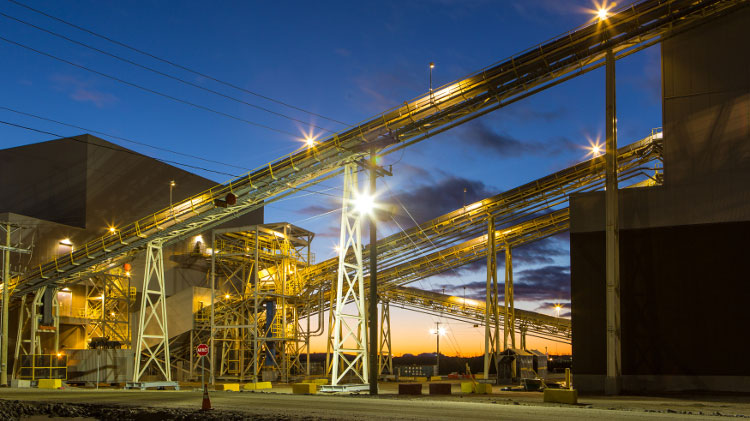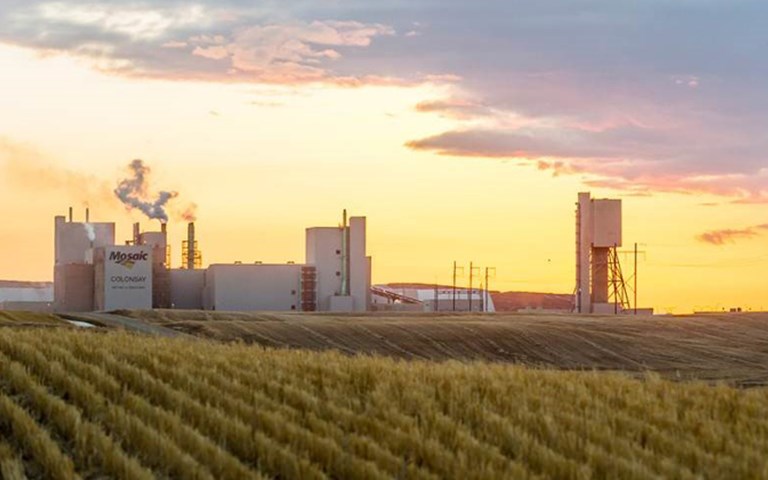Mosaic’s Colonsay operation improved production by 50 per cent thanks to an overhaul of the mine’s facilities and leadership model. Courtesy of Mosaic
In late 2014, management at Mosaic’s Colonsay potash operation was fighting for a chance to increase the company’s share of exports from Canpotex, the firm that manages the Saskatchewan potash exporting industry. Potash companies split shares of the firm’s tonnage based on the capacity of their facilities, and as such only produce enough to meet demand. But Mosaic had recently completed an expansion of Colonsay’s east mill, which triggered a special event known as a Canpotex run – the best 90 out of 120 days of intense production to define the capacity of its improved facility – and a chance to grab hotly contested market share.
In collaboration with consulting firm CLG, Colonsay underwent a systematic overhaul of both the mine’s facilities and leadership model. “We proved out 2.8 million tonnes,” said Brian Marshall, general manager of the Colonsay mine, which is located about 60 kilometres east of Saskatoon. This amounted to about a 50 per cent improvement in production at the mine, which previously had a nameplate capacity of 1.9 million tonnes. “That was well beyond what we thought we were going to get. We were expecting that if we hit the mark we would get about 2.5 million tonnes.” At the same time the mine achieved a reduction in safety incidents by 50 per cent. After the run, Mosaic’s share of the Canpotex exports increased by 1.78 per cent to 40.55 per cent.
Downtime is frown time
Preparations for September 2014, when the Canpotex run started, began more than a year in advance. “They pulled me in to get them ready,” said Marshall, a 36-year veteran of the mining industry who, the year before, had helped Mosaic’s Esterhazy operation go through a Canpotex run of its own.
Many miners are familiar with the concept of maximizing productivity over the long term, but very few ever need to do it for just 120 days, where any downtime can result in a lower allocation of Canpotex’s exports. “It’s a pretty special time,” said Marshall. “You’re hitting on all cylinders and you do things to keep the place running that you wouldn’t normally do. You give it a lot of overtime; you maintain equipment well past what you think it needs. The old part of the mill that we had is 50 years old, so you get into it and you think, ‘What are the things that could take us down during this Canpotex run?’”
Teams focused on improving critical assets that could cause major delays; the hoist and the mill were two of the most important.
“We did a full upgrade on our hoist,” said Marshall. “We rebuilt the motors to a bigger spec so they could handle more torque. We had skips that were capable of holding 30 tonnes, but were running at about 27, so we increased the load, and we also decreased the cycle time of the skip by about 20 seconds. That brought us from 800 tonnes per hour (tph) on the skip to about 1,100 tph.”
The usual approach to Canpotex runs is that operations push production to its limits before something breaks, but Colonsay opted to do things differently. During the run, the mill shut down for a day every week to do regular maintenance. While this meant equipment availability was very good (mill availability improved 19.2 per cent over baseline), it also made mill startup procedures very important, and left less room for unexpected shutdowns. “When you’re into a Canpotex run, the way it works is at seven o’clock in the morning you need to start shoving full tonnage through the mill,” said Marshall.
Operational knowledge found to be lacking
While the maintenance schedules got revamped, it became clear that the mill personnel had never received the proper training to do their jobs. “We realized that over a number of years we’d lost the experience in our mill and the guys didn’t understand how to actually run the mill,” recalled Marshall. “They really didn’t understand the circuits themselves. That was a big surprise. We had to pull these operators out and give them some formal training.” To do this they brought back the previous mill manager, Neil Anderson, from retirement. He had worked at the operation for more than 30 years, and was given the task of coaching and mentoring staff on how to get the mill running efficiently.
“When you get an operation that’s been around for 50 years, and people turning over for 50 years, every time somebody trains somebody else on how to operate a piece of equipment you get something different,” said Marshall. “We’ve standardized that training now when people come on board.”
The types of things operators often need to know are subjective, and need to be carefully transferred from one generation to the next. Things, said Marshall, like “Just looking at a flotation circuit and saying, ‘Here’s what you should see coming out the other side. Here’s what the water should look like and here’s the amount of froth you should have on it.’ What they were doing before that was just turn it on, and what they got, they got.”
Behaviour science in action
“CLG was on site and they’re a behaviour science group, so they look at why people do what they do,” said Marshall, who worked closely with consultant Laura Methot. Good results from the Canpotex run were critical for Mosaic as a whole, but could only be achieved if everyone was working in unison toward the same goal. Luckily, Mosaic had already planned leadership training at the mine, and it just happened to coincide with such a critical project.
“There really are five things that the best leaders do more of than the rest,” said Methot, who conducted “turbo sessions” with mine management team members at the mine to educate them about how leadership is best modelled. These behaviours, she said, are: set clear expectations, monitor performance, enable barrier removal, provide feedback and coach employees for improvement.
But all the theory in the world is of no use without some way to check if changes are having an effect. CLG and Mosaic tracked leader behaviour and were able to correlate the successful execution of leadership behaviours with crew level improvements and ultimately with better results on the ground. At the crew level, for example, safety observations increased and the number of injuries went down after leaders were able to outline how much they expected employees to focus on safety.
“The thing that Colonsay did better than many of the other clients we work with is the integration of this behaviour change methodology with visual management,” said Methot. Visual management boards are white boards that leaders use to track key metrics, and help employees stay on the same page.
“A supervisor would have a board on a wall where he’d write in the day’s production, any safety issues, anything that was talked about the previous day, just getting communication out,” said Marshall. “It was a fairly big change. With the underground guys, they wanted to know what the recovery was in our mill. They’re working hard to get the ore up the shaft, but they want to know what they’re doing with it up there. Getting that kind of information out there helped with morale.”
Though another Canpotex run is unlikely in the near future, Colonsay is well set up now to deliver at full capacity when the potash market picks up (the newer mill is currently offline). “We have a philosophy that when the mill is running, we’re running at full rates. If the market doesn’t demand it, we run it full and then we take it offline and we do maintenance. [The winter of 2014-15] we hit our lowest cost per tonne that we’ve ever seen.”



